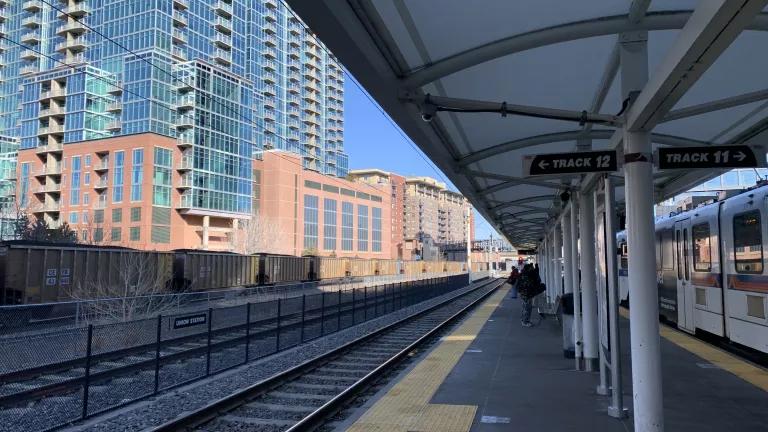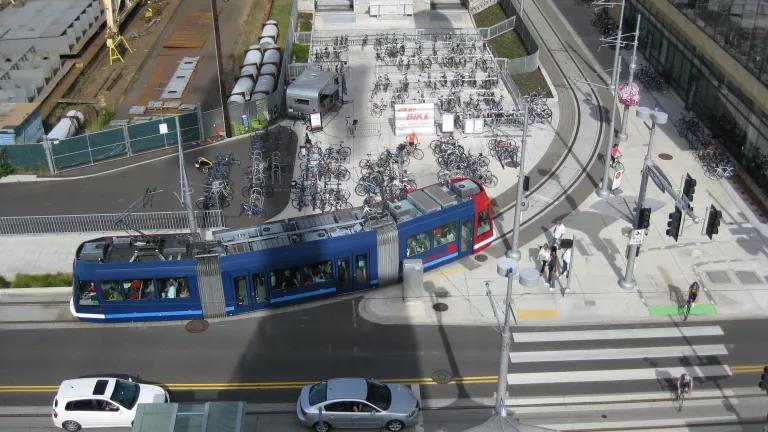Building a More Sustainable, Affordable Colorado with Thoughtful Housing Strategies
Land use reform proposed by Colorado leaders could deliver a triple victory for climate, air quality, and housing affordability.

Housing located next to the Denver Union Station in Colorado
Alana Miller/NRDC
Governor Jared Polis’s State of the State address in January 2024 posed the question of what Colorado should look like on the state’s 150th birthday in 2026, Polis’s final year in office. The cornerstone of his vision was an issue on the minds of many Coloradans: housing.
Building more housing in Colorado can improve people’s quality of life, clean our air and water, improve the economy, and expand access to opportunities for work and play for all Colorado residents. Achieving all those goals together nonetheless requires careful attention as to where we build that housing—namely, near transit and in already developed areas—as well as the types of housing we build, allowing for more diverse types of homes to ensure affordability for all.
Governor Polis summed this up in simple terms: “What it comes down to is creating a Colorado where people from all backgrounds can live in homes they can afford, near accessible and reliable transportation options—buses, bikes, and walkable neighborhoods.”
The problems holding us back from achieving this vision are acute in Colorado. A January poll commissioned by Centennial State Prosperity found that 95 percent of Coloradans, across geographies and party lines, think the cost of renting or buying a home in the state is a problem, and strong majorities of Coloradans support state action to build more and more diverse types of housing, in line with a strong body of research that makes it clear that housing costs rise when housing availability is limited by restrictive local zoning rules.
The Colorado legislature has also taken up the issue, proposing numerous bills that seek to increase housing supply and make housing more affordable—and crucially, in ways that also prevent sprawl and reduce emissions. Three bills could help guide Colorado housing policy toward a future with less air and climate pollution and more affordability for all types of households.
Expanding transit-oriented communities
By strategically concentrating housing, businesses, and amenities around transit hubs, we can create communities where residents can easily access public transportation and reduce their reliance on personal vehicles. This not only combats climate change and dangerous air pollution, but it also fosters more efficient and accessible communities.
As communities grow around transit, more households tend to choose to own fewer cars, leading to reduced transportation costs for residents—often the second-highest household expense after the cost of housing itself. A 2023 MarketWatch survey found that 40 percent of drivers surveyed said they couldn’t afford other household necessities due to the high costs of car ownership, maintenance, fuel, parking, and insurance. Expanding access to public transportation and creating walkable communities where people live provide low-cost and low-carbon options for people to meet their daily travel needs.
There are numerous benefits for residents living near transit. Studies have confirmed that living near transit also reduces how much people need to drive; for instance, an article published in the Journal of Public Transportation found that residents living in transit-oriented communities make an average of 44 percent fewer vehicle trips. Additionally, upward economic mobility is significantly higher in more compact areas with access to multiple transportation options.
By allowing more housing units to be built near frequent transit stations like bus rapid transit, light rail, and commuter rail, Colorado can strategically increase housing supply and include more affordable types of units. This helps reduce household costs and commute times, expands access to opportunities, and preserves open space by focusing growth in already developed areas.
Removing arbitrary parking mandates
An often overlooked yet powerful policy tool to reduce housing costs is the undoing of parking mandates. For the last several decades, city regulations have mandated a minimum number of parking spaces for new developments, encouraging car-centric urban planning. By removing these minimums, we free up valuable land, reduce the cost of housing, reduce urban sprawl, and encourage more sustainable transportation options.
The elimination of minimum parking requirements helps rightsize the amount of parking included in each development and reduces the overall cost. Minimum parking requirements often force parking to be overbuilt and underutilized. For instance, a study by the Regional Transportation District (RTD) in the Denver area found that market rate housing developments near RTD transit stations have 40 percent more parking than utilized, even at the busiest times, while low-income housing has 50 percent more parking than is used.
This has a tremendous impact on cost. Studies in Colorado indicate that structured parking spaces in garages cost $25,000 each to construct and off-street surface parking costs up to $10,000. Each parking space requires up to 2.5 times its square footage in driving area, consuming valuable real estate that could otherwise be devoted to providing more housing. According to analysis from the Southwest Energy Efficiency Project, a developer could build one affordable home for the cost of eight new parking spaces in a garage.
Rather than forcing a one-size-fits-all minimum number of spaces in an area, Colorado is considering eliminating parking mandates, in favor of each project developing the amount of parking needed for that particular property. The state is also interested in providing data analysis for jurisdictions on parking supply and utilization rates, as well as an analysis of tools to help reduce the need for parking, including shared parking agreements, pricing mechanisms, and incentives to encourage the use of more efficient options like public transportation.
Strategically planning growth
A key piece of the housing affordability puzzle lies in strategically planning for new development. Instead of haphazardly siting new housing developments, cities, counties, and the state can plan for growth by identifying the areas most suitable for new housing, increased density, and mixed-use developments. This ensures that as communities expand, they do so in a way that minimizes environmental impact and maximizes affordability and transportation access.
By concentrating development in specific areas, we protect natural habitats from sprawl and reduce the ecological impact of growth. This approach also fosters community resilience by promoting a diverse mix of housing options, services, and employment opportunities. Planning for housing in areas with existing services—like transit, roads, water, utilities, and other infrastructure—also makes more efficient use of existing resources, further reducing taxpayer costs while preserving Colorado’s undeveloped ecosystems.
Strategic growth policies must require local communities to undertake housing needs assessments to understand how many and what type of new units the community needs, as well as require housing action plans that will lead to the development of adequate new housing. Investments in infrastructure, water, and transit by the state, regions, and local jurisdictions must then align with the strategic growth plans, tying available funding to the implementation of housing action plans. Legislators should push for a strong bill that will achieve equitable, efficient outcomes for future housing development.
The structure of our communities—their walkability, accessibility, and affordability—is a direct result of policy decisions and a policy framework that prohibits most forms of housing. Rather than artificially limiting the housing supply through regulation, Colorado is looking to expand options so more housing gets built to meet the needs of more Coloradans. Other bills under consideration in this session would complement these reforms by adding provisions to protect renters and low-income homeowners from unsafe living conditions and displacement. By expanding housing density near transit, reducing space wasted on car storage, and planning thoughtfully for future needs, Colorado can build more sustainable, vibrant communities.




